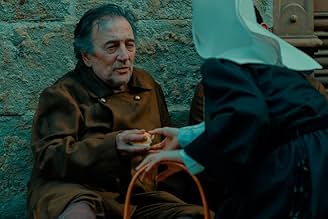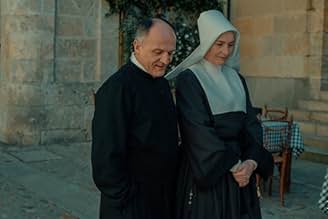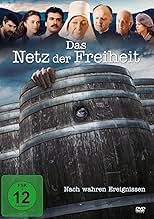Ajouter une intrigue dans votre langueThe incredible life of Helena Studler, a nun and Daughter of Charity that created a non-violent network that rescued over 2000 people in Nazi occupied France during WWII.The incredible life of Helena Studler, a nun and Daughter of Charity that created a non-violent network that rescued over 2000 people in Nazi occupied France during WWII.The incredible life of Helena Studler, a nun and Daughter of Charity that created a non-violent network that rescued over 2000 people in Nazi occupied France during WWII.
- Récompenses
- 2 victoires et 1 nomination au total
Silvia Garcia
- Sor Cecilia
- (as Silvia García)
Histoire
Commentaire à la une
This interesting story is inspired on actual facts , dealing with the incredible life of Helena Studler, a nun and Daughter of Charity , also called Sister Helena (1891-1944), was a nun of the congregation of the Daughters of Charity of Saint Vincent de Paul of Metz and a member of the resistance French, recognized for having organized the escape of more than two thousand fugitives under the Nazi regime during World War II. Nicknamed "the French Schindler", she was distinguished with the National Order of the Legion of Honor and the Croix de guerre with palms. As the nun Helena Studler turns into the rescuer of the persecuted by Nazis by creating a non-violent network . The nun Helene clandestinely within the shield of the Red Cross' diplomatic immunity to shelter allied prisoners from the Gestapo. Helena masquerades in order to outwit the German plans in occupied France.
This engaging story drags in some place but was professionally realized and contains nice cinematography and evocative musical score . The flick narrates faithfully by means of flashbacks her fights , ambitions , dreams , aims , and activities , seed sown on good ground has borne much fruit . At the ending the scene where the good but detained nun and the Nazi bad guy , finally confront each other is a high point . Stars Assumpta Serna who gives a fines well as likable interpretation as Helena Studler, a tenacious and brave nun who opens paths in the field of freedom and in the defense of the prisoners and rights of the pursuers . Her acting is full of vitality and enthusiasm . Well filmed entirely on location in France and Spain . The motion picture was adequately directed by Pablo Moreno who previously made other though-provokingand religious films as ¨Pablo De Tarso¨, ¨Alba¨, ¨Un Dios Prohibido¨ and his last one :¨Luz De Soledad¨ .
The actual events are the following ones : Helena Studler entered the company of the Daughters of Charity of Saint Vincent de Paul in 1912 under the name of Sister Helena. At the outbreak of the First World War, she was expelled from the Seminary of Belletanche near Metz -then in German Lorraine- for being French. After the signing of the armistice on November 11, 1918, which established, among other demands, the immediate withdrawal of all the troops of the German Empire from the territory of Alsace-Lorraine, he was able to return to Metz to serve in the Saint Nicholas Asylum (Hospice Saint- Nicolas) , the oldest hospital in the city. In July 1940 Moselle was de facto annexed to the German Third Reich. Metz had been declared an open city on June 14 and German troops entered the city on June 17. On June 29, a branch of the Gestapo moved into Metz. The defeated French government did not protest. . The French prisoners wandered around, sick and without means of subsistence, and were mostly herded into Fort de Saint-Julien, a military installation near Metz. The Daughters of Charity of Saint Vincent de Paul of Metz first obtained a permit to receive donations and help the prisoners. When that permission was revoked, Sister Helena obtained another to visit prisoners in Saarbrücken, Stuttgart, Mannheim, Nuremberg, Karlsruhe, and Wiesbaden. The successive caravans of prisoners arriving in Metz and the chaos that this generated gave Sister Helena the opportunity not only to provide care and food, but also to start organizing an escape network with the participation of many families in the city. Various resistance movements arose in the rest of the Moselle department and were not always coordinated with each other. As in Alsace, the peculiar form of this compromise was the passage and intelligence channels, which were generally dismantled by Nazi repression. On August 15, 1940, on the occasion of the Solemnity of the Assumption of Mary celebrated in Place Saint-Jacques, in the presence of Bishop Joseph-Jean Heintz and in front of a statue of the Virgin Mary, Helena led the singing of a anthem that implied the faith of the inhabitants and their opposition to the annexation of Metz to the German Third Reich: «Queen of France, pray for us, our hope, come and save us!!» ("Reine de France - Priez pour nous - Notre espérance - Venez et sauvez-nous!"8 The participants in the celebration deposited at the foot of the statue the flowers that formed a tricolor carpet with a layout similar to that of the French flag. The occupation authorities took the opportunity to expel Bishop Heintz the next day, while many priests and inhabitants of Metz suffered the same fate or were deported Heintz fled to Lyon where, with the permission of Archbishop Pierre-Marie Gerlier, established the official seat of the diocese of Metz. But Sister Helena's runaway network was well organized: she had few direct employees who were responsible for receiving the "packages" (runaways) at different places, usually churches, and escorting them to the train or bus station,8 supplying them with supplies. Tickets or tickets, and instructions for the journey and arrival. They delivered their "packages" to carriers who followed them at a distance, either to the train stations at Rosselange, Moyeuvre-Grande, or Amanvillers, or to bus destinations, usually Saint-Privat-la-Montagne, Sainte-Marie-aux- Chênes or Montois-la-Montagne. Arrived at their destination, the transporters entrusted them to families or organizations that took care of accommodation, clothing, the delivery of false documents and the passage to the unoccupied area. Thus, more than two thousand fugitives benefited from that escape network to elude the Gestapo in Metz and reach the free zone, among whom the then young Lieutenant François Mitterrand -later President of the Republic-24 and his personal friend Roger-Patrice Pelat, Boris Holban, and French General Henri Giraud, Charles de Gaulle's counterpart in the Free French movement. On January 11, 1941, the nun organized the escape of Boris Holban, a Romanian communist of Jewish origin, who between March 1942 and 1944 operated as an organizer and military leader of the FTP-MOI resistance groups - Snipers and Partisans. Immigrant Labor-from the Paris region. Holban dedicated the end of his life to writing a book in which he recounted his escape and praised the figure of Helena Studler. Sister Helena also collaborated in the escape of the young priest Marius-Félix-Antoine Maziers who escaped from a Nazi stalag along with 42 companions using a sewer , he was later appointed Archbishop of Bordeaux.
This engaging story drags in some place but was professionally realized and contains nice cinematography and evocative musical score . The flick narrates faithfully by means of flashbacks her fights , ambitions , dreams , aims , and activities , seed sown on good ground has borne much fruit . At the ending the scene where the good but detained nun and the Nazi bad guy , finally confront each other is a high point . Stars Assumpta Serna who gives a fines well as likable interpretation as Helena Studler, a tenacious and brave nun who opens paths in the field of freedom and in the defense of the prisoners and rights of the pursuers . Her acting is full of vitality and enthusiasm . Well filmed entirely on location in France and Spain . The motion picture was adequately directed by Pablo Moreno who previously made other though-provokingand religious films as ¨Pablo De Tarso¨, ¨Alba¨, ¨Un Dios Prohibido¨ and his last one :¨Luz De Soledad¨ .
The actual events are the following ones : Helena Studler entered the company of the Daughters of Charity of Saint Vincent de Paul in 1912 under the name of Sister Helena. At the outbreak of the First World War, she was expelled from the Seminary of Belletanche near Metz -then in German Lorraine- for being French. After the signing of the armistice on November 11, 1918, which established, among other demands, the immediate withdrawal of all the troops of the German Empire from the territory of Alsace-Lorraine, he was able to return to Metz to serve in the Saint Nicholas Asylum (Hospice Saint- Nicolas) , the oldest hospital in the city. In July 1940 Moselle was de facto annexed to the German Third Reich. Metz had been declared an open city on June 14 and German troops entered the city on June 17. On June 29, a branch of the Gestapo moved into Metz. The defeated French government did not protest. . The French prisoners wandered around, sick and without means of subsistence, and were mostly herded into Fort de Saint-Julien, a military installation near Metz. The Daughters of Charity of Saint Vincent de Paul of Metz first obtained a permit to receive donations and help the prisoners. When that permission was revoked, Sister Helena obtained another to visit prisoners in Saarbrücken, Stuttgart, Mannheim, Nuremberg, Karlsruhe, and Wiesbaden. The successive caravans of prisoners arriving in Metz and the chaos that this generated gave Sister Helena the opportunity not only to provide care and food, but also to start organizing an escape network with the participation of many families in the city. Various resistance movements arose in the rest of the Moselle department and were not always coordinated with each other. As in Alsace, the peculiar form of this compromise was the passage and intelligence channels, which were generally dismantled by Nazi repression. On August 15, 1940, on the occasion of the Solemnity of the Assumption of Mary celebrated in Place Saint-Jacques, in the presence of Bishop Joseph-Jean Heintz and in front of a statue of the Virgin Mary, Helena led the singing of a anthem that implied the faith of the inhabitants and their opposition to the annexation of Metz to the German Third Reich: «Queen of France, pray for us, our hope, come and save us!!» ("Reine de France - Priez pour nous - Notre espérance - Venez et sauvez-nous!"8 The participants in the celebration deposited at the foot of the statue the flowers that formed a tricolor carpet with a layout similar to that of the French flag. The occupation authorities took the opportunity to expel Bishop Heintz the next day, while many priests and inhabitants of Metz suffered the same fate or were deported Heintz fled to Lyon where, with the permission of Archbishop Pierre-Marie Gerlier, established the official seat of the diocese of Metz. But Sister Helena's runaway network was well organized: she had few direct employees who were responsible for receiving the "packages" (runaways) at different places, usually churches, and escorting them to the train or bus station,8 supplying them with supplies. Tickets or tickets, and instructions for the journey and arrival. They delivered their "packages" to carriers who followed them at a distance, either to the train stations at Rosselange, Moyeuvre-Grande, or Amanvillers, or to bus destinations, usually Saint-Privat-la-Montagne, Sainte-Marie-aux- Chênes or Montois-la-Montagne. Arrived at their destination, the transporters entrusted them to families or organizations that took care of accommodation, clothing, the delivery of false documents and the passage to the unoccupied area. Thus, more than two thousand fugitives benefited from that escape network to elude the Gestapo in Metz and reach the free zone, among whom the then young Lieutenant François Mitterrand -later President of the Republic-24 and his personal friend Roger-Patrice Pelat, Boris Holban, and French General Henri Giraud, Charles de Gaulle's counterpart in the Free French movement. On January 11, 1941, the nun organized the escape of Boris Holban, a Romanian communist of Jewish origin, who between March 1942 and 1944 operated as an organizer and military leader of the FTP-MOI resistance groups - Snipers and Partisans. Immigrant Labor-from the Paris region. Holban dedicated the end of his life to writing a book in which he recounted his escape and praised the figure of Helena Studler. Sister Helena also collaborated in the escape of the young priest Marius-Félix-Antoine Maziers who escaped from a Nazi stalag along with 42 companions using a sewer , he was later appointed Archbishop of Bordeaux.
Meilleurs choix
Connectez-vous pour évaluer et suivre la liste de favoris afin de recevoir des recommandations personnalisées
Détails
- Date de sortie
- Pays d’origine
- Site officiel
- Langue
- Aussi connu sous le nom de
- The Network of Freedom
- Sociétés de production
- Voir plus de crédits d'entreprise sur IMDbPro
Box-office
- Montant brut mondial
- 180 584 $US
- Durée2 heures 5 minutes
- Couleur
- Rapport de forme
- 1.78 : 1 / (high definition)
Contribuer à cette page
Suggérer une modification ou ajouter du contenu manquant

Lacune principale
By what name was Le réseau de la liberté (2017) officially released in Canada in English?
Répondre
![Regarder Tráiler [OV]](https://m.media-amazon.com/images/M/MV5BYWYzZjljYTYtNmE5NS00ZjM2LWJkOTUtYTYxZGE5ZDZmZTRhXkEyXkFqcGdeQXRyYW5zY29kZS13b3JrZmxvdw@@._V1_QL75_UX500_CR0)



















